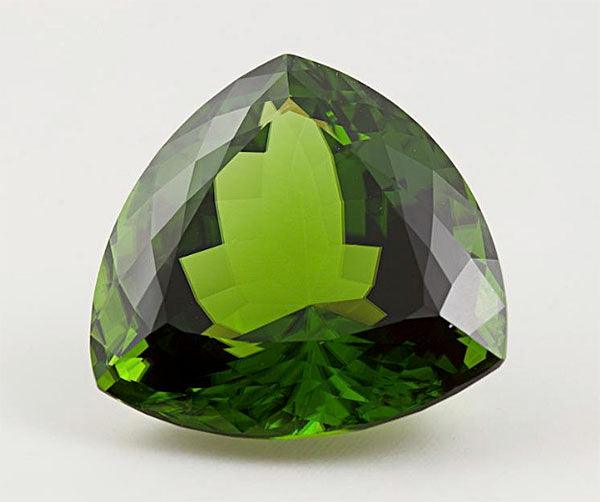Tipping the scales at an impressive 100.15 carats, this triangular-cut peridot is one of the world’s most striking examples of August's birthstone.
Mined in Pakistan and exhibiting an exceptional vivid green hue, the gem has been part of the Smithsonian's National Gem and Mineral Collection since 2011. The Smithsonian obtained the gem with funds provided by the Tiffany & Co. Foundation.
Peridot is one of only a few gemstones that occurs in just one color. The amount of iron in the crystal structure determines the green gem's intensity and tint. Specimens can range from yellow-green through olive green to brownish green.
According to the Gemological Institute of America, the most favored peridot color is a richly saturated pure grass green.
Peridot has been coveted for more than 3,000 years. According to the Smithsonian, ancient Egyptians fashioned beads from golden green peridot crystals mined on an island in the Red Sea. The island was known to the Greeks and Romans as Topazios and its verdant bounty (today’s peridot) was known as topazion until the 18th century.
Mahana Beach on Hawaii’s Papakolea coast is one of only four green sand beaches in the world. The beach sand on the Big Island’s undeveloped southern tip is rich in the mineral olivine (gem-quality olivine is known as peridot). Olivine is a common mineral component of Hawaiian lavas and one of the first crystals to form as magma cools.
Locals refer to peridot as the “Hawaiian Diamond,” and small peridot stones are sold as “Pele’s tears” in honor of Pele, the goddess of volcanoes. In ancient Hawaiian chants, Pele was described as “She-who-shapes-the-sacred-land,” and her temper was known to be both as abundant and dangerous as the lava.
Peridot is currently sourced in the US (Arizona), Myanmar, Norway, Brazil, China, Australia, Pakistan and Vietnam. Peridot is also one of the few interstellar gems. Pallasitic meteorites contain iron dotted with olivine.
Mined in Zebirget, Egypt, the world’s largest faceted peridot weighs 310 carats and, like today's featured gem, resides at the National Museum of Natural History in Washington, DC.
In addition to being an official birthstone of August — along with spinel and sardonyx — peridot is the 16th anniversary gemstone.
Peridot has a hardness of 6.5–7 on the Moh’s scale, which means that it is a relatively soft gemstone best suited for earrings, pins and pendants, according to the American Gem Trade Association.
Credit: Photo by Ken Larsen, Smithsonian.


